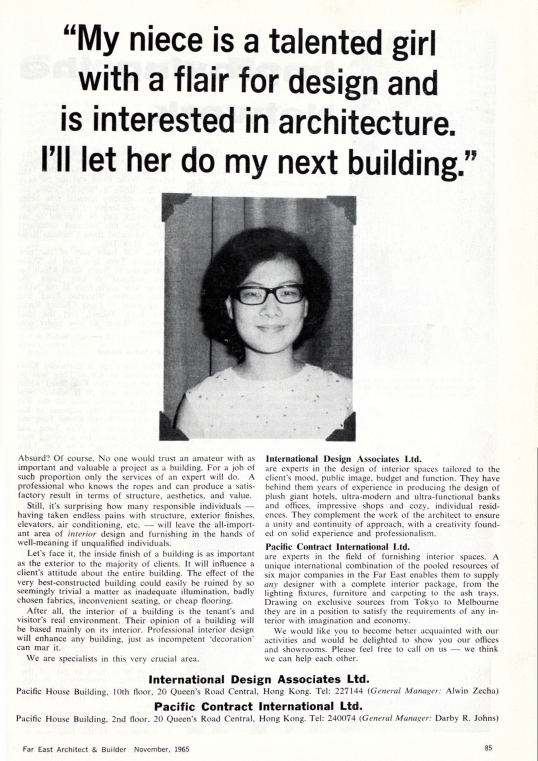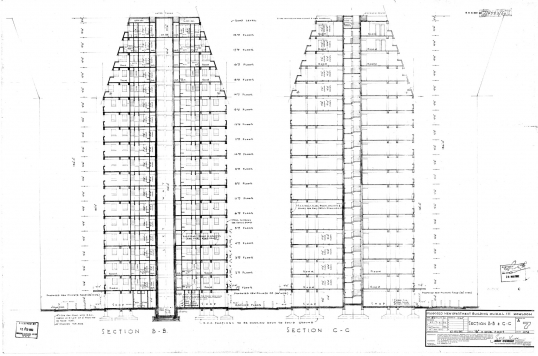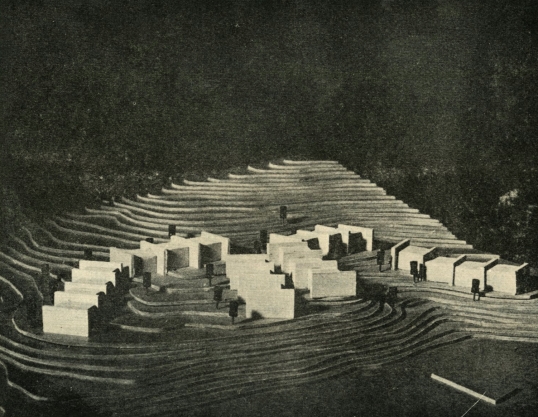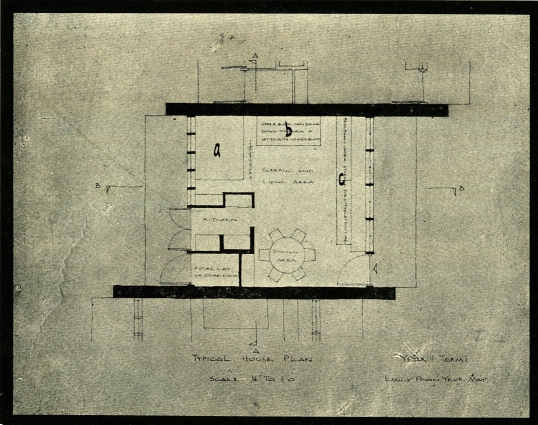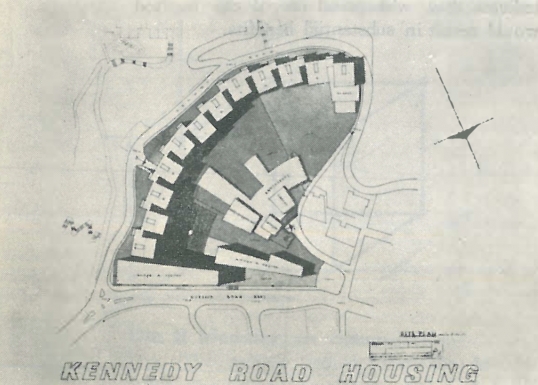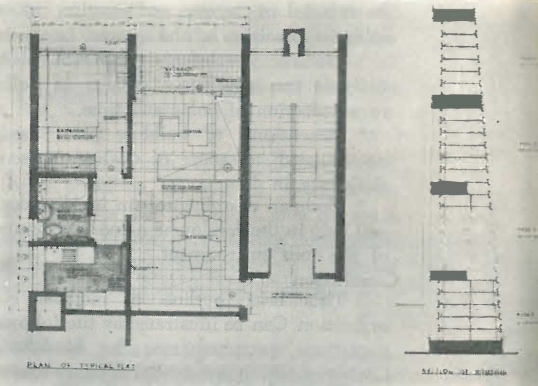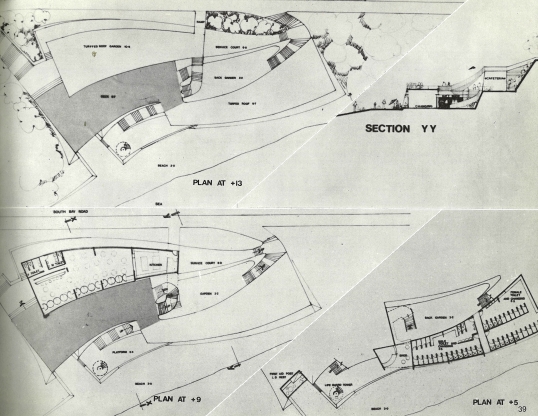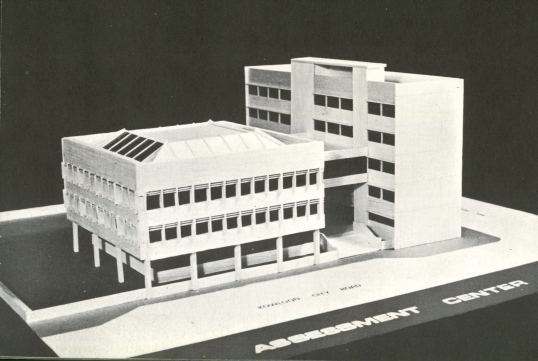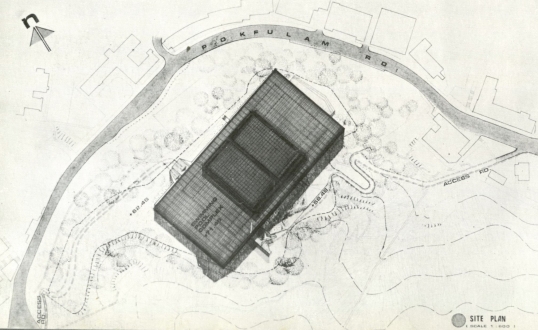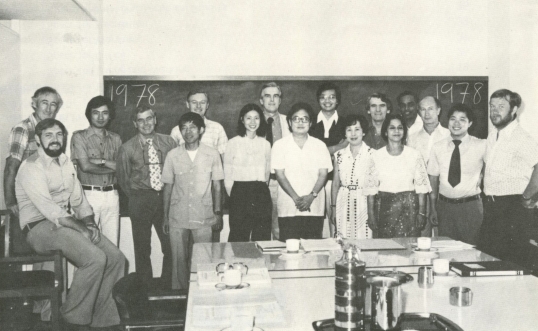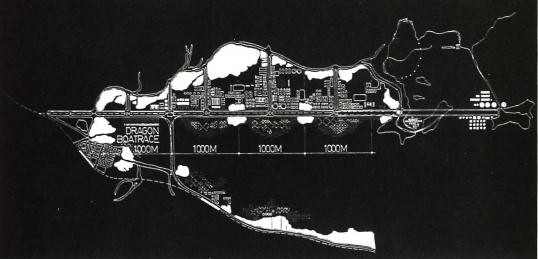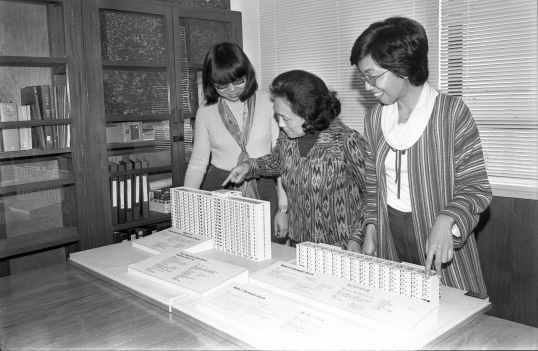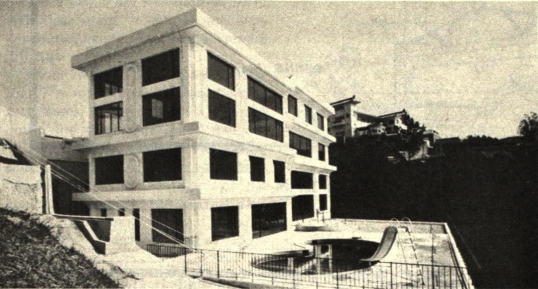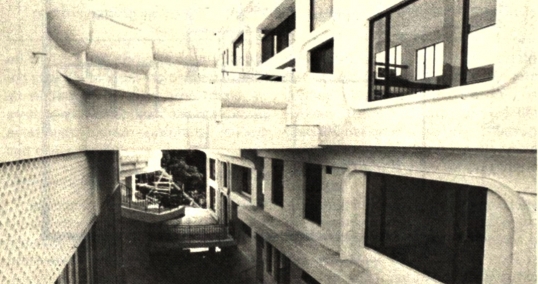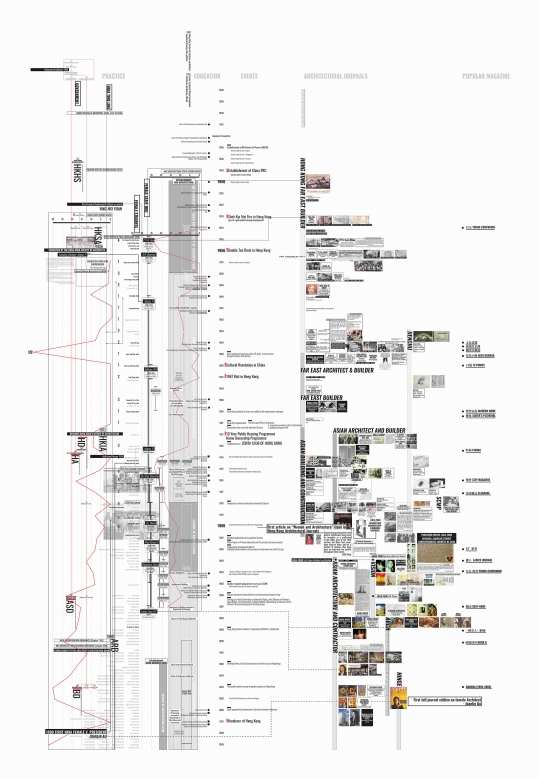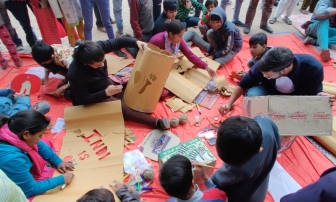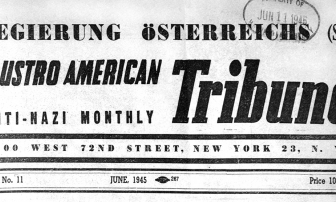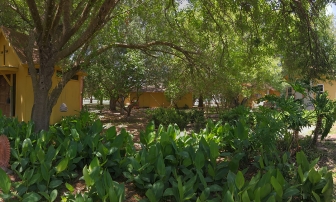Working Women and Architectural Work: Hong Kong 1945–1985
Where are the women in Hong Kong’s architectural history? Asking this question reveals two issues. First, in the early twentieth century, women rarely stepped out of familial and Chinese state patriarchies and hierarchies to enter the workforce, let alone to practice architecture.1 Second, those who did have been hidden in the records behind collaborations in a system that privileges monographic authorship of buildings.2 In 1953, when Cheng Ying-Hsi first appeared on the authorized architects’ registry of Hong Kong, women comprised over one third of the 100,776 industrial workers among the city’s population of 2.25 million.3 The majority of women industrial workers had moved to or returned to Hong Kong from mainland China. After the end of the Japanese occupation in 1945, Hong Kong experienced a sudden transformation in the industrial workforce with the arrival of migrant women. These women were gendered in every spatial encounter—in the factory, the office, and the homes—and in representations of their spaces and bodies. Imbricated in the story of this transformation were the architectural laborers, those who worked in architectural offices in design or management, those who taught, and those who were directly involved in construction work. Their activities have been absent in historical accounts of Hong Kong architecture.4
To write the history of women and architecture in Hong Kong, a historiographical and feminist project of recuperation is necessary, one that begins with the construction of an archive that situates women’s labor.5 Postwar economic and urban development in Hong Kong was a process of overlapping displacements: the colonial forced displacement of Asians, followed by the transformation of workspaces, conditions, and practices brought about by transnational capitalism, trade diaspora, and labor migration.6 The history of women architects offers a method for understanding this process.7 I address Asian women subjects and subjectivities through archival, ethnographic, and biographical methodologies, describing a “critical consciousness of ‘Asia’” as an imagined entity comprising societies shaped by imperialisms, diasporas, and transnational capitalisms and examining “inter-Asian” women’s biographies.8 I see this as part of an ongoing effort to write an intersectional history capable of mapping the contours of feminist agency through a recuperation of migrants’ archives.
The archive situates women and their work in the context of extreme labor migration in postwar Hong Kong. Crafting the archive is a process that involves finding working women—who they were, where they were working, what they worked on, and why they did the work—in a dense aggregation of texts, images, objects, people, and places. The archive comprises governmental census records and annual reports, building department drawings, newspaper reports, journal articles and advertisements, women’s magazines, commercial films, documentaries, oral interviews, and symposium conversations with women who did architectural and industrial work, as well as site, office, and home visits. Archive-building involves studying how working women were defined, described, and represented by identifying the activities and platforms through which their work is made visible. It also attends to systems and organizations such as the inbuilt inequality in colonial public institutions, gendered writing in newspapers, and building journals that prevented women’s work from being known and understood.
Industrial Work
Hong Kong’s industrial development and urbanization after the Second World War were shaped by the experiences, networks, and institutions of Chinese migrant labor. These, in turn, were framed by the nationalist-communist civil war on the mainland and the impact of the United States and the United Nations’ embargo on strategic commodities such as rubber and tin, which curtailed Hong Kong’s role as a trading entrepôt but jumpstarted the colony’s export of manufactured goods. When the British resumed sovereignty after the Japanese surrendered in 1945, Hong Kong’s population was 1.6 million.9 There were 903 factories and workshops employing 30,000 workers (20,000 men and 10,000 women). Of these, the lowest-paid factory workers were women feather workers and the highest paid were male weavers, with a difference in daily wages of a factor of seven.10 Women tended to perform work that is conventionally considered to be unskilled or lower-skilled. In August 1950, the Fung Keong rubber manufactory, one of the colony’s oldest makers and exporters of rubber shoes, shut down with only a day’s notice, suddenly putting its 1,200 workers, mostly women, out of work.11 Citing the surge in rubber prices as the reason for its closure, the local management of the company—which was headquartered in British Malaya—was instructed by Hong Kong’s immigration office to repatriate the workers who came from mainland China within five months.12 While many did return, others stayed and sought part-time work. When the head office decided to reopen the factory on a part-time basis in January 1951, the workers’ union notified those who had left that they could return.13 For the rest of the 1950s, the rubber factory weathered high prices and diminishing markets.14 In 1967, following labor unrest and mounting debt, Fung Keong shut down its Hong Kong operations for good.
In 1962, the East Sun Textile mill had to cut one third of its production due to US restrictions on imports.15 Cheng Kit Wah, a Hong Kong–born woman of Hakka descent who worked as a “shuttle girl” in the East Sun Textile factory in Kwun Tong between 1961 and 1964, describes the non-stop operation of the mills, where work was organized in three shifts.16 As she received no training to become a weaver, her job was to place and replace the shuttles in a large room of thirty to forty loom machines—something that entailed standing for eight hours at a time. The weavers and shuttle workers were all women, and the floor supervisors were mostly from Shanghai. Despite the long hours and noisy and stuffy working conditions, work in the textile factory was highly sought after by uneducated, untrained women like Cheng. According to her, “It was really difficult to get a job in a weaving factory—you need connections! I was lucky enough to have someone helping me back then; people were so envious of how lucky I was!”17 She stopped working at the factory when her first-born child arrived in 1964 and took up piecework from home.
Cheng’s story is typical; many women factory workers worked from their homes after they had children. Until the establishment of the Industrial Training Advisory Committee in 1965, recruitment and training of female industrial workers was haphazard; many Chinese factories hired relatives and acquaintances of existing workers.18 In 1953, Governor Alexander Grantham opened the Ho Tung Technical School for Girls.19 To “balance between boys’ and girls’ education,” the school provided a three-year secondary education during which girls enrolled in “specially selected vocational subjects such as dress-making, cookery, laundry-work, house craft and commercial practice.” The intention was for the girls—mostly from poor homes—who were deemed “unsuited to the more scholastic type of instruction in secondary grammar schools” to “not only earn a living before marriage but also to be better housewives afterwards.”20 The South China Morning Post, Hong Kong’s main English-language daily, identified these teenage girls as “potential first-class housewives, couturieres, secretaries and craftswomen.”21 By the end of the 1960s, the industrialized women visibly inhabited the architecture of the new high-rise factories, resettlement housing estates, and composite buildings (private mixed-use developments).22
The Architect and the Factory Worker
In 1953, the Government Gazette announced a list of ninety-three authorized architects in Hong Kong.23 Only one woman made it onto the list: Cheng Ying-Hsi. In their 2007 book Architectural Footprints: The Story of the First Generation of Chinese Architects in Hong Kong, Ng Kai Chung and Chu Cheuk Hung ask if Cheng was indeed the first woman authorized architect in Hong Kong.24 They left the question unanswered, focusing instead on the first generation of professionally trained male Chinese architects in the colony. Wang Haoyu extended this research in her 2008 doctoral dissertation on the first generation of Chinese “migrant architects” in Hong Kong. Wang included a list of sixty-seven architects in an appendix, and again, Cheng Ying-Hsi was the only woman architect included.25 In contrast to her male contemporaries listed in the appendix, each with a long list of built projects to his name, the five-line description of Cheng’s professional experience covering nine years (1948–1957) contains no built work.26
What does Cheng’s presence as the lone woman among the postwar cohort of authorized architects reveal about the situation of women engaged in architectural work? How are we to understand Cheng’s lack of architectural activity and production in industrializing Hong Kong? With a Bachelor of Engineering degree from prestigious Tsinghua University in Beijing and a Master of Engineering degree from the University of Liverpool, Cheng had excellent credentials.27 She joined the Hong Kong and Whampoa Dock Company as an engineer in 1947.28 She was a founding member of the Engineering Society of Hong Kong and a member of Britain’s Women Engineering Society before becoming an authorized architect in Hong Kong.29 In 1954, she joined the Faculty of Architecture at the University of Hong Kong as the first full-time female member of the teaching staff.30 That same year, in her Ladies’ Day address at the Rotary Club, Senior Education Director Ho Cheng spoke of “much progress in forty years” for women in Hong Kong with regard to greater access to secondary and tertiary education, full-time employment, and participation in public service.31 But this claim seems premature. Cheng’s labors were invisible in Hong Kong’s architectural development, as they ran counter to the gendered stereotypes of work.
Architect-engineer Cheng and factory-worker Cheng found themselves in a similar situation of receiving lower remuneration than their male counterparts and suffering from discrimination against married women in the workplace.32 In the 1930s, a letter by South China Morning Post reader “a single girl” accused married working women of greedily taking jobs from women in less fortunate economic situations and of shirking their home-keeping duties.33 A response letter by a male reader reinforced “the greedy women” characterization. He called out employers as the “chief offenders” for hiring married women who were not in need of money for office positions that he felt were more suited for “presentable young girls.”34 The impact of the Great Depression and the political exigencies in the mainland reinforced the idea that well-paid work should primarily be for men and that the proper place for married women was in the home, as unpaid workers, with their single counterparts taking up low-paid “women’s jobs.” Set against the protracted discussion of the emancipation of women by mainland reformist intellectuals and women’s increased participation in public life in inter-war Britain, the newspaper debate highlights Hong Kong’s entrenched, systemic patriarchy.35
Public discourse in Hong Kong on “women who work” shifted towards pay equality in civil service in the late 1950s. Actualization, however, took much longer.36 Equal pay for men and women was the subject of discussion at the Council of Women meeting in 1952.37 Despite the petition for equal pay from the YWCA and support by the Reform Club, the Salaries Commission Report of 1959 concluded that there was insufficient information “to formulate a principle to support equal pay for men and women,” though it made an exception for “men and women medical officers,” who could be “remunerated on equal terms.”38 In his support for equal pay, Brook Bernacchi, chairman of the Reform Club, identified teachers, nurses, and office and factory workers as the four categories of women who were particularly affected by pay inequality.39 In 1962, about fifty non-pensionable female doctors in the civil service petitioned the government for equal pay.40 This triggered debates among government officials, representatives of civil service staff associations, and members of the public. Following the publication of the Report on the Women’s Salary Scales in the Public Service in October 1962, single women officers within the professional scales began receiving pay equal to their male counterparts.41 Equal pay for women was one of the five key priorities at the Hong Kong Urban Council elections of 1965. Despite these developments, the definition of “equal pay for equal work” remained contested.42
By 1967, most economically active women between fifteen and thirty-four years of age were working in the manufacturing industry, with the majority in textiles, trading, commerce, and community service.43 Named colloquially and in the newspapers as “factory girls,” “office girls,” “shop girls,” “elevator girls,” and “tea ladies,” they formed an active consumer class. Increasingly exposed to global trends due to the circulation of magazines, newspapers, and events in the city, the nascent local clothing industry identified these working women as its models and customers. In the building industry, advertisements depicted the modern working woman as the arbiter of taste and the organizer of the efficient interior. Always fashionably dressed, she is the representative of “beauty with privacy” for Levolor Blinds, coyly peeks from behind a heavy door with an elaborate Schlage lockset, comes down a Hitachi “escalator for good looking efficiency” wearing a cheongsam while conversing with her male colleagues in their suits, and is the model for countless other products selling beauty and taste with images of efficiency and economy.44 In an advertisement showing the seven key departments of Lamson Pneumatic Carrier Tubes from 1958, the woman employee occupies the two positions at both ends of the process: personnel and frontline sales. In real-estate rental ads, “office girls,” teachers, and young married couples are described as desirable tenant types.45 At the same time, the expanded visibility of working women saw increased occurrences of gendered work stereotypes in public discourse. As the public representation of women became dominated by this new office class, the female architectural worker, like the factory worker, remained in the background.
Interior Work
Interior design, while reinforcing and drawing from gender stereotypes, became a design field for women. Lana Cheung, Hong Kong’s first foreign-trained woman interior designer, participated in the colony’s first Ideal Home Exhibition in 1960. A South China Morning Post article covering her design of an ideal home for the exhibition, titled Lana’s Flat, describes her as “a pretty girl with good dress sense and the bearing of a fashion model.”46 Cheung, whose father was a builder-developer, left for the University of Manitoba with the intention of studying architecture, only to be advised by the dean of international student affairs to enroll in its inaugural interior design program. She graduated in 1956 with a thesis award and a bronze medal from the Design Institute of Manitoba. Upon her return to Hong Kong in 1957, she found that the city had no interior design or industrial arts programs. But there were small furnishing and decorating firms who offered interior decorating services through consultants.47 Cheung was the first woman to set up her own independent interior design practice in Hong Kong.48 Throughout the 1960s, she designed and furnished the interiors of various hotels, offices, and residences, including offices for commercial airlines such as Cathay Pacific, Air India, Japan Airlines, and British Airways.49
Cheung’s interior design career is illustrative of the predicament of professional women. While she was acknowledged as a professional interior designer in the interview for the first article in the “Ideas for Interiors” series—a weekly column in the South China Morning Post that ran from April to November 1966—the writer introduces her through her husband, the architect James Kinoshita.50 The series is replete with gender stereotypes, and Cheung was the only Chinese woman designer from Hong Kong to be interviewed.51 After a decade of work, she directed her energy to raising the four children she had with Kinoshita. Eventually, increased demand for interior design for the new offices, hotels, residential spaces, and commercial spaces in Hong Kong led universities to offer new courses. Interior design was offered under the Fine Arts section in the University Department of Extra-Mural Studies at the University of Hong Kong in 1959.52 Beginning in 1962, additional courses included “Design in the House,” taught by lecturer in architecture Jon A. Prescott; “Design and the Home,” taught by graphic artist Alex Bleszynski, visiting from the Warsaw School of Design and Graphic Arts; and industrial design courses taught by artist Paul Selinger and graphic designer Henry Steiner.53 By 1962, there were about ten established interior design firms with interior design consultants who had architectural training. Although the majority of design consultants were men, women were acknowledged as “experts” because they seemingly had “more feminine and sympathetic intuition” in the realm of interiors.54
A 1965 advertisement for an interior design company took the feminine trope even further by placing a portrait photograph of a woman below a headline that reads: “My niece is a talented girl with a flair for design and is interested in architecture. I’ll let her do my next building”55 (fig. 1). The rest of the lengthy text is devoted to refuting the headline, beginning with the exclamation, “Absurd? Of course. No one would trust an amateur with as important and valuable a project as a building.” It went on to make a case that for “a job of such proportion only the services of an expert will do. A professional who knows the ropes and can produce a satisfactory result in terms of structure, aesthetic, and value.” Stating that “the inside finish of a building is as important as the exterior to the majority of clients” and that “the interior of a building is the tenant’s and visitor’s real environment,” the ad claims that professional interior design would enhance any building, as opposed to “incompetent ‘decoration’ that can mar it.”56 The insistence that only a company could execute the task overlooked the labor of individual designers like Cheung, and reinforced the trope that the woman’s rightful place is in the interior.57 When women appeared in advertisements for building materials, equipment, and home furnishings, they were invariably presented as consumers and as model occupants of the modern interiors.
Fig. 1. Advertisement for International Design Associates.
Far East Architect and Builder (November 1965): 85.
The new buildings of industrializing Hong Kong accommodated the intersecting spatial experiences of the woman factory worker, interior designer, and architect. In March 1968, the newly incorporated Kin Shing Studio released the melodrama film The Blossoming Rose (also known as The Forsaken Love) just months after the labor unrests subsided in December 1967.58 In the film, the industrial district of San Po Kong is bustling with newly completed offices, factory buildings, and automobiles. In the opening sequence, the camera pans across the street in bright daylight, moves up the whitewashed modern factory building and into the garment factory filled with neat rows of young women working at their sewing machines. Her work done, the stack of blouses neatly set aside, Siu Ping changes from her samfoo to a Western-style black shift dress, picks up her book bag from the floor next to her sewing machine, and takes a bus to night school.59 The scene cuts to a classroom, giving insight into another aspect of the gendered society of industrial Hong Kong, where ambitious factory workers attend night school in hopes of getting an office job with better working conditions and wages. The factory setting characterizes the shared experiences of women from Guangdong who fled to Hong Kong.60 The narrative of a schoolteacher caught in a love triangle between a poor “factory girl” and a rich socialite embodies the wealth inequalities and aspirations for social mobility deeply ingrained in Hong Kong society.61 As a temporary occupant of the factory, school, dormitory, café, and dance hall, Siu Ping is never quite at home. Nevertheless, women like her were a highly visible presence in the city.
The ten-story light industry factory building where Siu Ping works was completed in 1964.62 Owned by Shiu Chi To, founder of Hing’s Cotton Undergarments and the Bethlehem Knitting Factory, the building was designed by Steven Siu Lun Yue, a Hong Kong architect involved in many redevelopment schemes in the 1950s and 1960s.63 Factory buildings made up a significant part of the extensive portfolios of architects like Yue, as well as émigré-Chinese architects including Chien Sing Shou from Jiangsu, Chou Chen Lu from Zhejiang, and Robert Fan Wenchao from Shanghai.64 Until the end of the 1960s, no women were listed as architects on record for the numerous buildings commissioned and constructed in the territory.65 However, staff photographs of private architectural offices and government departments in journal publications show that women were present.66 As it was not a practice to list the project team members in publications, and projects designed by architects working in government service were attributed only to the corporate body of the department, there is little evidence on how the women were involved in the new factories, high-rise apartment buildings, and commercial and public complexes that formed the cityscape of industrial Hong Kong. Women architects and their work remained hidden within the nomenclature of bureaucracy.
Architectural Work
The writing away of an entire sex in the context of Chinese as well as British colonial patriarchy was sustained across the public and private sectors. In government service, at the Public Works Department (PWD), and in the university, women consistently received lower remuneration. In 1948, the first woman who worked at the PWD was paid eighty percent the amount that a male colleague with the same position was paid.67 In the late 1950s, a woman lecturer at the University of Hong Kong earned three quarters the salary of her male counterpart.68 However, tuition fees were not gender-differentiated. At its commencement in 1951, there were forty-four first-year and forty-two second-year undergraduates in the newly established Faculty of Architecture at the University of Hong Kong. Six were women.69 The ratio of one female to fourteen male students was far from that of the factory workers, at one to two. In a 1953 public lecture on architecture in Hong Kong, Gordon Brown, the first professor and dean of the architecture school, spoke on the “Real Talent in Young Men.”70 In his lecture, he commended the good work that was produced by the first cohort of ninety students in the three-year program and their potential to be excellent draftsmen. He stated that students were recruited from colonial territories in the region: Hong Kong, Singapore, Malaya, Amoy, Formosa, Indonesia, Siam, Swatow, Penang, and Sumatra. The nine women in the school were subsumed under the overarching category of “young men” and “draftsmen.” Most of the women were from families that were engaged in the building, real estate or manufacturing industries.
There were four women among the first batch of graduates in 1955: Anna Lam Pui Ying, May Li Yuet Kwan, Wong Siu Ling, and Doreen Young Tsin Wai.71 Lam went on to pursue a Master of Architecture degree at McGill University and remained in Canada to practice architecture. She was the only woman architect engaged on the Place Ville Marie Project in Montreal, designed by Henry Cobb of Pei Cobb Freed & Partners.72 Li died in an accident in San Francisco in 1958. Wong joined the Hong Kong firm Eric Cumine Associates immediately after graduation and became an authorized architect in 1958. Young, one of five graduates to obtain first-class honors, left for the United States to pursue her Master of Architecture degree at Harvard. There she met Robert Fan Zheng, son of the influential Shanghai architect Robert Fan Wenzhao.73 Upon graduation, she worked at Raymond and Rado and at Skidmore, Owings & Merrill in New York. When she returned to Hong Kong, she joined Eric Cumine Associates and was part of the team that designed Man Wah Sun Chuen, a large, eight-block private housing estate on reclaimed land in Yau Ma Tei, in the south of the Kowloon Peninsula (fig. 2). Local news media covered Young’s achievements, from her outstanding high-school scores to her becoming the first woman to pursue architecture at the University of Hong Kong, her graduate studies at Harvard, her architectural tour of Europe, and her marriage to Robert Fan Zheng. However, there was no mention of her work as an architect.
Fig. 2. Section B-B & C-C of Proposed New Building by Eric Cumine Associates on KML 111 Kowloon, 1962. Young was listed as one of the architects for the building, which was part of an eight-block development completed in 1970. Only Young’s academic credentials (M.Arch. Harvard) are indicated.
HKSAR Buildings Department.
Young’s sister-in-law Gloria Fan Yen I graduated from the University of Pennsylvania in 1950, the same school that her father, Robert Fan Wenzhao, attended. In 1955, she made the news as the first woman to practice architecture in the colony. A list of her credentials was published: her studies; her work at the Museum of Modern Art in New York and in the offices of Roy Larsen, Eero Saarinen, and Richard Neutra; and the fact of Robert Fan Wenzhao being her father.74 Her return to Hong Kong after her partnership with John C. Worsley and collaborations with A. Jane Duncombe in San Francisco was likewise publicized.75 In the 1960s, Fan and Young left the territory and disappeared from local news. Little is known of their careers afterwards.76 Lam and Wong entered public service. Despite their academic credentials and their reputation as talented students, these women architects were excluded from public discourse on architecture in postwar Hong Kong.
Invisibility does not imply non-participation. After Doreen Young, only one woman, Alice Lam See Him, graduated from the University of Hong Kong in 1957. That year, fourth-year student Fanny So became secretary of the Architectural Society. She was responsible for organizing the end-of-year architectural exhibition and annual ball.77 So was one of three women among the fifteen graduates of 1958. The other two were Phyllis Chow and Simmy Edith Cheng.78 One summer, Cheng’s father recommended her to the Hong Kong office of Kwan, Chu and Yang Architects. Despite a positive interview, the partners told Cheng that they could not accommodate a woman in their office, which was full of smoking and swearing men.79 “They said that they would have to create a special office space just for me,” she recalled. She spent yet another summer color-rendering building plans at the office of Robert Fan Wenzhao.
In 1958, upon graduation, Cheng, Chow, and So joined the Public Works Department. Theodore L. Bowring, the department’s director and chief architect was an external examiner at the University of Hong Kong and often hired recent graduates. In 1956, the year the first council of the Hong Kong Society of Architects was elected, five percent of the staff at the PWD were women.80 Cheng spent two years there as an assistant architect, designing the staircase details for the Queen Elizabeth Hospital and working on government apartments on Princess Margaret Road and elsewhere. According to Cheng, the PWD offered her job security despite the pay inequality—a woman assistant architect’s pay was a quarter less than that of a male architect.81 At the time she joined the department, only a tenth of the staff were women. Cheng explained that for the women graduates, working in government service was the best, if not only, option.82
The Faculty of Architecture
Equality in remuneration was hardly an issue of contention in the first decades of the Faculty of Architecture. There were very few women on the teaching team and they did not stay long. In its first two years, Gordon Brown, the faculty’s chair, led a small team consisting of a senior lecturer, two lecturers, and a few demonstrators.83 In 1951, W. Shackleton, a student of Brown’s at the Architectural Association, became the first woman part-time lecturer.84 In 1955, the Chinese engineer-architect Yuan Cheng Ying Hsi joined as a full-time lecturer.85 She taught building construction and the theory of structure. Dagmar Rosalie Bowring, daughter of Theodore L. Bowring, joined the faculty as a teaching assistant in 1956. In 1957, Brown left his position for the United States, Cheng returned to Beijing, and Bowring left the faculty, possibly to return to the United Kingdom with her family.86 Senior lecturer Wallace G. Gregory became dean in 1958. The faculty was amalgamated into the Faculty of Engineering and Architecture later that year. There were no women lecturers until Mary Patricia Mayne joined in 1960.87
Mayne was the only woman among the twenty-seven architects who founded the Hong Kong Society of Architects in 1956. Shortly after she joined the university, she became an authorized architect and was one of the Hong Kong delegates to the Informal Conference on Education held at the Royal Institute of British Architects (RIBA) in London in 1961, convened by Maxwell Fry.88 Her report on the conference concluded with a note on the Architectural Association School of Tropical Architecture, where the secretary, Leo de Syllas, highlighted the importance for research on tropical and subtropical conditions of climate to be conducted in tropical places themselves.89 Besides design courses, Mayne taught architectural history with H. Gunter Hollmann, Bjorn Nedberg, and P. A. Reed. She lectured on Minoan, Mycenaean, and Greek architecture in the first year of the three-year history curriculum introduced by Brown and continued during Gregory’s deanship.90 The BArch course was granted recognition by the RIBA in 1961 and by the Commonwealth Association of Architects in 1968.91 Mayne was the first woman to be formally inducted to the founding council of the society in 1964.
Simmy Cheng and Fanny So became authorized architects in 1961. Cheng worked with Wong Hong Yuen at United Architects and Engineers and So joined the office of architect-engineer Szeto Wai in Hong Kong.92 In 1963, Cheng became the first female member of the Hong Kong Society of Architects from Hong Kong. After her, Agnes Mary Tam (BArch 1960) took up membership in 1964 and worked at Harriman Realty until 1966, when she continued independent practice and set up Mountain Folkcraft, an antiques and crafts shop in the Central District.93 So left for Singapore after getting married in the early 1960s.94 Enrolment of female students remained low throughout the 1960s, between one and three each year.95 Twelve women graduated with a Bachelor of Architecture degree between 1961 and 1969. 1961 graduate Carol Wong Choi Fong joined the Architectural Office of PWD and worked her way up to become the first woman chief architect of the department by 1980.96 It was only in 1972 that another woman architect, 1969 graduate Eliza Kwong Mee Yee, became a member of the Hong Kong Institute of Architects (HKIA).97 Of the fifty-seven members who joined the institute between 1960 and 1969, four were women, and by 1974 there were twelve women among the 253 members.98 In all, women made up one tenth of HKIA’s membership in its two decades of growth.
In February 1968, the government finally proposed granting women in civil service equal pay beginning in 1975.99 That it was going to take another seven years for women to receive equal pay caused a strong reaction among the women’s-rights advocates and led the government to reissue another statement in early 1969 to clarify that equal pay would be introduced gradually from April 1969 and fully achieved in 1975. For expatriate women lecturers like Mayne, this meant getting a monthly pay and living allowance commensurate with the men’s only after fifteen years of full-time work. A 1935 British law that prohibited women from working at night—since overturned in the UK—was still in effect in Hong Kong, which meant that women who could only take up factory work at night due to family obligations were often exploited as they could not be paid legally.100 The idea of women working at night was contested by South China Morning Post contributor Valerie Davies, who believed that it “could destroy family life” and called for equal pay to be considered with regard to its implications for the “standard family structure.”101 Davies, who ran a “Mainly for Women” column in the newspaper between 1968 and 1970, lamented what she saw as the decline of women’s influence in the home and the accompanying weakening of family ties.102 In 1970, statutory maternity leave was introduced under the Employment Ordinance, followed by a marriage reform that prohibited polygamy and instituted women’s right to inheritance. Although these measures seemingly affirmed the presence of the working woman, the nature of her work and her commitment to it continued to be undermined in public and popular media, and her upward mobility in the workplace remained limited.103
Jienchu
In 1963, the Architectural Society at the University of Hong Kong founded the student magazine Jienchu (Architecture, or, Building), a publication with a focus on architectural education and practice in Hong Kong. Jienchu’s documentation of projects makes it possible to see the range of work done by women at the university. In the first years of the magazine, the editorial board was split between those who saw it as an academic newspaper and those who wished for it to appeal to popular interests. The editors described the resolution of the debate as a “compromise” and gave space mainly to architectural education and student work. Following the foreword by Gregory, the editorial pages, and an essay in memory of Gordon Brown—who died suddenly in 1962—the inaugural issue opens with two essays on the practical training and profession of the architect. Four student projects addressing housing issues were featured, including a village housing project for the New Territories by third-year student Emily Poon Yeuk May, the only female student in her graduating class of 1965 (figs. 3–4). Poon describes her group’s involvement in the planning of forty houses on a burial site, supplemented by a model of the master plan and a section and plan of a typical house.104 Maintaining minimal disruption to the existing landscape and the economy of house unit structure and construction, the design reflects the concerns of resettlement housing and the development of the New Territories in the early 1960s.
Fig. 3. Site model for a village housing scheme by Emily Poon.
Jienchu (1963): 56.
Fig. 4. Plan of a typical house for a village housing scheme by Emily Poon.
Jienchu (1963): 58.
Jienchu was the first publication and main platform for the work and ideas of architectural students and female graduates from the University of Hong Kong through the 1960s. The 1964 issue includes the work of four female students: a hostel village for the Chinese University of Hong Kong designed by Choa Kin Ling, a Catholic church by Patti Lai Suk King and Annie Lo Hung Suen, and an Anglican church by Joy Ling Shang as part of their third-year church design project.105 Ling was the third-year student representative of the fifteen-member University Architectural Society headed by Gregory. The only other female member was Annette Chang, who was the first-year student representative. Lo and Ling’s final thesis projects—a fashion school and an urban redevelopment at Kennedy Road and Queen’s Road East respectively—are also featured in the 1967 issue.106 Both projects are indicative of the cultural and urban transformation in the city. Lo’s fashion school was a direct response to the booming textile-manufacturing industry, which saw increasing demand for art and fashion design education in the city.107 Ling’s urban redevelopment project to preserve and rehabilitate existing residential buildings in Central was a direct response to the government’s redevelopment efforts (figs. 5–6).108 In 1969, fourth-year architecture student Mabel Yeung So Hing won the competition for the design of an exhibition kiosk sponsored by the Productivity Centre to showcase the work of the Productivity Council,109 part of the Chinese Manufacturers’ exhibition that ran from November 1969 to January 1970.110 This was the first time a design project was publicly credited to a Hong Kong woman architect, albeit one in training.
Fig. 5. Site plan for Urban Redevelopment – Project A by Joy Ling.
Jienchu (1967): 50.
Fig. 6. Plan of typical flat for Urban Redevelopment – Project A by Joy Ling.
Jienchu (1967): 50.
The 1970s saw the increased participation of women architecture students and critical opinion in Jienchu. Graduate student Susan M. Palmer’s essay “Social Trendy, Videofreak or Pseud,” in the 1974 issue, describes three types of architectural students in the United Kingdom: the first is concerned with social and community issues, the second obsessed with video media, and the third preoccupied with psychological concerns. The essay begins with how the toddler of a final-year student and the eight-year-old daughter of a lecturer formed part of the architectural studio environment.111 Palmer’s candid description of the lives of British architectural students is one of nine articles preceding the student projects. Others include Gregory’s “Where Do We Go from Here?”, Barry F. Will’s “No Man’s Land and Everyman’s Space,” Robert H. Collis’s “A Plea for Conservation,” and J. J. H. Lau’s “Stop the World … I Want to Get Off!,” each a reflection or question that preoccupied the architect and student in relation to the extensive urban development taking place in Hong Kong. The student projects reflect the school’s response to the burgeoning trade and leisure industries. Featured projects include the design for a restaurant, changing room, and guardroom complex at South Bay Beach by second-year student Annie Wong and a building trades school by a team of fourth-year students including Anna Kwong Sum Yee b (fig. 7).112 Esther Chan Wai Fong’s team project for Lei Cheng Uk Estate and the General Post Office redevelopment scheme, published in Jienchu 1974 and 1975, planted the seeds for her later engagement in public service.113 Chan served on the Central and Western District Board in 1985 and was a member of the Town Planning Board in the mid-1990s.114
Fig. 7. Plans and section of South Bay Beach Complex by Annie Wong.
Jienchu (1974): 39.
For Jienchu 1975, second-year Bachelor of Arts in Architectural Studies student Julie Chu Kwok Wah headed the editorial board of nine that included two other women, final-year Bachelor of Architecture students Yuen Siu Ling (assistant editor for articles) and Jennifer Tsui Yuk May (editorial secretary and treasurer). The issue includes Chu’s design for a students’ workshop retreat in Tsing Yi and Olivia Tam Tin Wai’s tent structure for the second-year Dragon Boat Festival Pavilion.115 Two of Annie Wong’s fourth-year projects are featured: a Hong Kong University Art Centre based on the idea of “inter-communicating spaces” and a multi-story commercial building in Central that attempts to innovate within the maximum development allowance of the building ordinance.116 Jienchu 1976 includes second-year student Joanlin Au Chung Leung’s critical analysis of the new Shaw Brothers’ Film Studios. Opening with the statement, “Real architecture is the expression of emotion,” the essay describes how an architect is stimulated by “humanistic expression” and “structural expression.”117 Following Au’s piece, Nora Leung Kwok Ping’s poetry-style essay, “From Paper to Concrete” could be read as a Hong Kong rejoinder to Susan M. Palmer’s review of the British architectural student.118 Leung describes the Hong Kong architectural student as focused, highly productive, and attuned to the urbanization that they were participating in. The reciprocity with Hong Kong’s urbanization, especially the expansion of infrastructure and public services, is a recurring theme in the magazine. This was evident in the types of projects covered, such as Julie Chu’s planning and design of a workers’ holiday colony, Helena To’s assessment center for people with developmental disabilities, Susan Cheung’s high-rise commercial building, and Esther Chan’s swimming pool complex (figs. 8–9).
Fig. 8. Model of Assessment Center by Helena To.
Jienchu (1976): [folio 9–10].
Fig. 9. Site plan of Swimming Pool Complex by Esther Chan.
Jienchu (1976): [folio 17–18].
The University of Hong Kong’s curriculum responded to development in Hong Kong and the surrounding region. In the mid-1970s, British building and construction industries with interest in rapidly developing Southeast Asia set up headquarters in Hong Kong. The city was also becoming a center for dealing in antiques, art, and craft. Regional tourist industries celebrated the indigenous and the exotic. In 1975, London-trained Sri Lankan architect Minnette de Silva joined the faculty of architecture as a lecturer. A RIBA–licensed architect with a number of housing projects in Kandy and Colombo, de Silva had just written the chapter on Sri Lanka in the revised version of Bannister Fletcher’s A History of Architecture.119 She introduced the architecture of “Asian civilization” to the second year of the architectural history curriculum with lectures on the architecture of Asia, South Asia, and Southeast Asia.120 When Malaysian Chinese architect Eric Lye Kum Chew became chair professor and head of the department in 1976, six lecturers were teaching the history of architecture survey course: Robert H. Collis, de Silva, Lye, Mayne, Nedberg, and Lionel J. Parkinson.121 De Silva taught first- and second-year courses on building materials, color, and shelter studies, as well as the environmental workbook visualization course and the design studio on ergonomics with John P. L. Wong in 1976–1977.122 In 1977–1978, she taught the second-year architectural design course on squatter resettlement in Ma Hang and, with Parkinson, an arts and crafts center in Stanley, on the southern peninsula of Hong Kong.123
Lye had an expansive idea of architectural education. He had been the chair of the Architecture Department at the University of Manitoba between 1970 and 1976, and he integrated the North American liberal arts curriculum into the British system in Hong Kong, emphasizing conceptual design and advocating local and vernacular culture. He sought to balance racial and cultural representation in the faculty and brought in individuals with a stake in the region (fig. 10). When Mayne departed in 1977, de Silva was the only woman lecturer on the faculty. Chinese American Dimon Liu, a Pratt Institute graduate, joined the department in 1978.124 Liu taught basic design, drawing, and color courses, and co-taught the first-year course on the design for a dwelling with de Silva in 1978–1979.125 De Silva returned to Sri Lanka in 1979, where she would embark on the design of the Kandy Arts Center.126 Australian architect Doreen King joined the department in 1980. Her book St. John’s Cathedral Hong Kong was published in December 1987, the year she—along with Liu—left the university.127 Liu directed her focus to human rights activism and writing. For de Silva, Liu, and King, the University of Hong Kong, and Hong Kong itself, provided a transitional space for the incubation of ideas.
Fig. 10. Teaching staff of the University of Hong Kong Faculty of Architecture, 1978. Dimon Liu is on the right of Eric Lye (center). To his left is the faculty’s secretary, Mrs. Yau, and on her left is Minnette de Silva.
Jienchu (1978): 11.
Jienchu was a platform for women architects to feature their student work, as many would not see their professional projects published nor be publicly credited for them. Among Mayne and de Silva’s students were Joanlin Au (BArch 1979) and Nora Leung (BArch 1980).128 Au was an exemplary student of Lye’s curriculum. In 1978, during her fourth year, she won the top prize at the World XIII Congress of Union of Institute of Architects Student Design Competition, held in Mexico City.129 Her proposal for an administrative space on the island of Cheung Chau is based on Taoist principles and symbolism, using the circle, square, mandala, and sphere.130 For her graduate thesis project in 1979, Au proposed Ecopolis, a vision for the future Tai Po Market, the rural district in the New Territories where she grew up. It provides a basic structural framework for “static” and “mobile” activity and service systems to interpret the crises of energy, economy, environment, and ecology. Besides Jienchu, the project was published in Business Standard and ARCH magazine (figs. 11–12).
Fig. 11. Cheung Chau Administrative Space by Joanlin Au.
Jienchu (1986): 158.
Fig. 12. Site plan of Ecopolis, “the middle of the road solution to curb deleterious effects of urbanization,” showing the north–south placement of high-rise residential blocks at left and a low-rise industrial zone at right by Joanlin Au.
ARCH 17 (1995): 89.
Professional Practice
In the 1970s, the expanded role of women in housing was publicly discussed in the newspapers, including in gendered stereotypes—often written by women journalists—of women “lending the feminine touch” to the design of domestic interiors and in reports on women joining the professions of architecture, planning, engineering, construction, and management. The restructuring of the Hong Kong Housing Authority (HKHA) as a government agency was a pivotal moment for public housing in the city. Having completed ten low-cost housing estates by 1970 and eleven more by 1975, the HKHA ramped up the provision of social amenities, especially commercial, recreational, and educational facilities.131 A newspaper feature on public housing development in 1977 identified Lau Yuk-Yuen, senior architect of the Housing Department at the HKHA, as the designer of the department’s office building. Featured alongside Lau were University of Hong Kong class of 1974 alumni Doris Kong Zee Wan and Anna Kwong, who had complete responsibility for the projects assigned to them (fig. 13).132 In her five years with the Housing Department, Kwong participated in the design and management of the first H-blocks at Cheung Wah Estate in Fanling and Cheung Ching Estate in Tsing Yi.133 While the department, with its staff of one hundred, was seen to be egalitarian in its hiring policy and in the government sectors in general, women architects expressed that it was difficult for them to set up private practice in Hong Kong, and the prevailing attitude was still biased against the abilities of women architects.134
Fig. 13. “‘We’ve come a long way since this model,’ senior architect Fong Lau Yut Yuen tells fellow public housing architects Doris Kong and Anna Kwong.”
“Three Pillars of the Housing Department,” South China Morning Post, March 31, 1977.
The majority of women graduates in architecture turned to government positions as soon as they obtained the requisite training and qualifications to practice under the title of “authorized person” at a private architectural office. Simmy Cheng and Anna Kwong explained that government posts offered the regular work hours and the job security not typically found in private practice.135 But these positions offered limited scope for the expression of an individual. The scale and speed of projects in Hong Kong demand a minimum office size that cannot be easily accommodated in the tight spaces of the typical Hong Kong home. However, there were exceptions. In 1974, the design practice of Guangdong-born Cecilia Yip Wai Kay came to attention. Yip was one of five women in her class of eighty at the University of Michigan.136 She worked in a firm specializing in educational buildings before returning to Hong Kong together with her husband to develop a real estate business.137 She taught briefly at the University of Hong Kong before establishing her practice in 1966, designing detached houses, apartment buildings, and multi-story office buildings with parking ramps (figs. 14–15).138 Beginning in the 1970s, she was vice-chairman of the Hong Kong Federation of Youth Groups and designed three youth centers. In 1981, she was named director of Po Leung Kuk (Society for the Protection of Women and Children), and served as vice chairperson of the board from 1983 to 1984 and chairperson from 1984 to 1985.139 She developed and designed a number of centers for children and the elderly.
Fig. 14. Front view of the duplex residence designed by Cecilia Yip, showing the terrace and swimming pool at Black’s Link, overlooking Deepwater Bay.
“Duplex Residences Provide Comfortable Living,” Asian Architect and Builder (December 1974): 25.
Fig. 15. First-floor approach to the duplex residence designed by Cecilia Yip.
“Duplex Residences Provide Comfortable Living,” Asian Architect and Builder (December 1974): 25.
A noticeable shift in the professional landscape occurred in the 1980s with a series of developments that captured public attention: a woman architect won the international competition for the Peak leisure center, women architects set up independent private practices or partnerships, journal coverage of women architects increased, and the overall number of women in the workforce grew. Californian Moira Moser worked in Iran for several years in the 1970s before moving to Hong Kong in 1978.140 She founded M. Moser Design and Planning and M. Moser Architects in Hong Kong in 1981.141 Moser was one of three architects selected to design the new American Club in Tai Tam in 1984 and was involved in the space-planning design of a number of high-rise office buildings in the city. A newspaper article covered her career, including extensive details about her personal life. A year earlier, in 1983, Zaha Hadid won the competition for the Peak club, the city’s first international competition.142 The March issue of the new architecture magazine Vision focused on the Peak. It includes a report from the jury, articles discussing Hadid’s work and references to historical avant-gardes, a discussion of the “competition system,” and an analysis of the relationship between built and paper architecture. The issue closes with editor Julia Fung’s interviews with five Hong Kong–based (male) architects on competitions as a way to generate “the best design solutions.”143 This was the first discussion in Hong Kong of a woman architect that focused on her design philosophy and approach rather than her physical appearance or demeanor.
The spotlight on Hadid and Moser confirmed the predominance of the autobiographical as a distinct characteristic of narratives of women architects. Following three months in Europe on a graduation traveling scholarship, Joanlin Au found work at David Russell Associates Hong Kong in late 1979. In 1982, she joined John S. Bonnington Partnership in London and the following year became the first woman architect from Hong Kong to join the team for Norman Foster’s project for the HSBC headquarters in Hong Kong. Over the next four years, Au developed specifications and wrote the technical reports for the building’s details, until she left to take up directorship at Ho and Partners Architects, a firm founded by her University of Hong Kong senior Bosco Ho. In 1989, Au became the first Hong Kong woman to join the HKIA council. After graduation in 1980, Nora Leung joined Wong & Ouyang, a prominent office set up by two members of the University of Hong Kong’s first class of graduates, Jackson Wong Chack-Sang and Ng Chun Man.144 Leung worked closely with Paul Rudolph, the architect of the Bond Centre. She founded Ku and Leung Architects in 1988 with her husband, whom she met at Wong & Ouyang. In 1987, Massachusetts Institute of Technology and Manchester University–educated Joan Leung Hing Yee founded LOTUS Architects with Eric Lye, then dean of the University of Hong Kong School of Architecture, and began teaching design courses. From that point on, her labor is discussed through the framework of the partnership.145
In the late 1980s, despite being the project architect who saw the buildings through to construction, Leung continued to face objections from potential clients who preferred a man for the task.146 Nevertheless, she and others who set up their own office or partnership in this period ushered in a transition, where women in architecture would not be described as exceptions in their profession. In 1992, the journal Asian Architect and Contractor profiled Leung and her work at LOTUS.147 Then in 1994, ARCH magazine devoted a special issue to Au and her work, including her thesis and twenty-eight projects that she led as design director at Ho and Partners, where she worked before establishing her private practice in 1997.148
Constructing an Archive: Working Women and Architectural Work
The May 1980 issue of the Hong Kong–based regional trade journal Asian Architect and Builder synthesizes the contradictory representation of the woman architect in Hong Kong’s transition to a center of finance. The feature article on women in architecture highlights the challenges they faced in professional practice.149 Titled “Women and Architecture: A Budding Romance” and written by Julia Fung, the article begins with questions pertaining to barriers of entry to the profession.150 Fung’s first interviewee, Joan Leung, who was then working in London, states that “the male/female line in practice severely hinders the full expression of women architects” but that it does not exist in the academy. Selected to showcase the range of practices of women architects, the other three interviewees are Kwong Oi Yen (University of Hong Kong BArch 1965), who held a senior position in the office of Eric Cumine; Srisurang from Thailand, who co-directed David Russell Associates; and independent practitioner Minnette de Silva from Sri Lanka.151 Fung’s article is bookended by two cartoon caricatures of the woman architect as an empowered professional in a gendered stereotype. The first shows the architect in a tight dress and high heels, wearing a hard hat and carrying a T-square. The other depicts the architect in a crane-operated gondola waving a stick at a group of construction workers below.
In an article published in a 1988 issue of ARCH entitled “Monologue: On Women Architects,” an anonymous writer identified only as “a woman architect” addresses the fraught identity of the woman architect.152 While the author unsurprisingly raises the issues of marriage and family life as taking a toll on women’s career development, and of biases towards women’s abilities to manage a project and a team, she points out that with only one school of architecture in the city producing only forty graduates a year, the local profession cannot afford to discriminate against female architects.
Earlier, the debate between architects Joanlin Au and Eddie Franco published in Asian Architect and Builder, June 1980, foregrounds the conflicting representation of the woman architect.153 Au calls upon men to take up equitable distribution of tasks and burdens. Franco, who describes himself as a single parent raising a daughter, questions the assumption of gender equality on the grounds of biological difference. He concludes that “any male dominated profession in a male oriented society will obviously be reluctant to assist a woman in achieving a position of equality (and never mind superiority).” To that, Au responds:
Let’s not waste time and energy talking about sexual differences and deriving from those differences generalized fallacies. Men and women can work together to make this a better world to live in. Here, I pause for an answer, right from you, NOW, MEN.
Au’s appeal to set aside sexual differences downplays the invisibility of women in architecture. In 1985, there were thirty-nine authorized women architects in Hong Kong.154 This was an increase from 1955, when there was only one, but the number nevertheless represents less than one tenth of all the architects in the city. Despite the fact that women constituted over half the population, a woman architect and her work were still understood and described as exceptional.155 Crucially, behind Au’s determined negation of gender difference is another form of displacement of women labor: the arrival of an immigrant and expatriate workforce coinciding with Hong Kong’s economic rise beginning in the late 1970s.156 Professional women worked in offices and on-site, as domestic workers from the Philippines, Indonesia, Thailand, Sri Lanka, and Nepal carried out labor at home.157 By 1981, the number of women in the textile, rubber, leather, and plastic manufacturing industries was comparable to the number of men, and in some cases greater.158 Women in professional and technical fields remained low, at less than one percent of the working professional population.159 The 1980s saw a significant number of women executives in insurance, real estate, and financial services.160 With universal education, the narrowing of the gap between women and men in post-secondary education, and the new wave of the female labor diaspora, the presence of women in the workplace was normalized. Calls for equity in visibility were drowned out by vociferous discourses around Hong Kong’s financialization and the impending transfer of sovereignty from the United Kingdom to China. The banking industry grew so quickly that by the end of the decade, experts recommended flexible working hours “to solve the crisis” of labor shortages, allowing married women with children to work again.161 By 1990, there were seventy thousand foreign domestic workers in the city.162
This attempt to examine gendered architectural labor in Hong Kong with women who worked through the patriarchy of the colony and the Chinese family, and amid the massive mobilization of migrant labor, industrial capitalism, and financialization necessitated remaking and rethinking the archive. Biographies of both Chengs, as well as, student journals, building journals, architectural magazines, newspapers, technical reports, drawings of prosaic details, interiors, housing, and other artifacts are repositories of architectural labor. This archive remains in construction, as the entangled histories of the gendered labor of these first- and second-generation Hong Kong architects and new migrants from mainland China, South Asia, and Southeast Asia are yet to be fully explored (fig. 16). To understand their experiences across these conditions of migration, we must also make multivalent interpretations of women architects and their work: this means shifting historiographical attention towards labor in biographical narratives as well. Writing, design, teaching, building, managing, and other types of labor are crucial to understanding architectural production. New narratives of women’s architectural work in Hong Kong require thick descriptions of women’s intersectional experiences.
Fig. 16. Visualization of the archive-in-construction. The working timeline shows the relationships and connections between individuals, groups, institutions, affiliations, events, publications, places, and projects.
Eunice Seng, with assistance from Ina Wu and Jennifer Lam, 2019–2021.
This research was supported by the Research Grants Council General Research Fund (Project No. 17608622) and the University of Hong Kong Global Partnership Fund. I wish to acknowledge support from University of Hong Kong Faculty of Architecture and Department of Architecture; Garfield Lam of the University of Hong Kong University Archives; Kwok Ying-wah for his recollections of four decades as executive officer at the department; Cole Roskam for sharing the materials he salvaged from the department’s archival room before its closure; the Hong Kong Institute of Architects; HKU alumni Julia Fung, and architects Joanlin Au, Corrin Chan, Ada Fung, Winnie Ho, Anna Kwong, Nora Leung and Joan Leung-Lye; Andrew Lee for introducing me to Simmy Woo; Sylvia Yu-Lam; M+ and in particular Shirley Surya for co-convening “M+ Matters: Conversations on Women, Architecture, and the City,” which provided the platform to present this research to the public for the first time; Miggy Cheng for facilitating and translating the interview with her mother Cheng Kit Wah; the theme editors Anooradha Iyer Siddiqi and Rachel Lee and Aggregate editors who generously read and critiqued the essay; Juan Du and S.E. Eisterer for their comments; Koon Wee, who read and offered insightful perspectives, especially at the beginning and end; and my students and research assistants Ina Wu, Jennifer Lam, Ella Forsberg, Amanda Hwa, Annie Lye, Sammie Ng, and Cheryl Trisnadi, whose labors and commitment bring added meaning to the project.
✓ Transparent peer-reviewed
Eunice Seng, “Working Women and Architectural Work: Hong Kong 1945–1985,” Aggregate 10 (November 2022), https://doi.org/10.53965/JPIE9054.
- 1
Professional recognition was initiated on September 3, 1956, when twenty-seven architects gathered to form the Hong Kong Society of Architects. As the membership of the society increased, recognition as an Allied Society was given by Royal Institute of British Architects. The society became an institute in 1972 and began to expand its activities. In 1990, the Hong Kong Institute of Architects Incorporation Ordinance (Chapter 1147) was enacted. At the time of writing, the Hong Kong Institute of Architects has over 4,700 members. Of the thirty-nine presidents between 1956 and 2020, two are women: Anna Kwong Sum Yee (2009–2010) and Ada Fung Yin Suen (2013–2014).
↑ - 2
The dominant trajectory of architectural history privileges built work and authorizes particular methods of knowing, techniques, and delineations of expertise using the monograph as evidence. For reasons of professional liability, project credit is given only to the architect-owner or principal-in-charge. The practice of attributing a project to the individual architect extends to publications. Members of project teams were typically not listed in drawing records or in professional and trade journals. For public works, project credits were attributed only to the government department. This practice continues today, as the professionals are civil servants within the governmental boards.
↑ - 3
Hong Kong Annual Report 1953 (Hong Kong, 1954), 25.
↑ - 4
See Ng Kai Chung and Chu Cheuk Hung, Architectural Footprints: The Story of the First Generation of Chinese Architects in Hong Kong, 21; and Haoyu Wang, “Mainland Architects in Hong Kong after 1949: A Bifurcated History of Modern Chinese Architecture,” PhD diss., University of Hong Kong, 2008, 373–374.
↑ - 5
The lack of an archive was a key issue foregrounded in “Conversations on Architecture, Women, and the City,” a public forum organized by the author and Shirley Surya of M+ at the Asia Society Hong Kong Center on November 23, 2019. Through discussions on the life and work of nine women and their roles in shaping the built environment in Asia, the forum explored the reappraisal of criteria and methods used to assess architecture. https://www.westkowloon.hk/en/event/conversations-women-architecture-and-city#overview See also, Anooradha Iyer Siddiqi, “Crafting the Archive: Minnette De Silva, Architecture, and History,” Journal of Architecture 22, no. 8 (2017): 1299–1336.
↑ - 6
Karen Burns and Lori Brown adopt the biography as a methodological response to a global narrative of gender, geography, and the geopolitics of knowledge production to provide “an affective politics for contemporary architectural feminism.” Karen Burns and Lori Brown, “Telling Transnational Histories of Women in Architecture, 1960–2015,” Architectural Histories 8, no. 1: 1–11.
↑ - 7
In her invocation of the question “Asian Women as Method?,” Laura Hyun Yi Kang addresses the intra-Asian violence and gendered labor exploitation that compels a scrutiny of “the contours of that nonunity” that constructs Asia. Laura Hyun Yi Kang, Traffic in Asian Women (New York: Duke University Press, 2020), 19–50.
↑ - 8
This term “inter-Asia” is attributed to Chen Kuan Hsing and Chua Beng-Huat Kang, who founded the Inter-Asia Cultural Studies journal in 2000. Kang attributes this “nonunity” to Chen, Chua, and others who name the critical consciousness of “the imaginary entity called ‘Asia.’” Chen Kuan Hsing and Chua Beng-Huat Kang, “Editorial Statement,” Inter-Asia Cultural Studies 1, no. 1: v.
↑ - 9
Hong Kong Annual Report 1946 (Hong Kong, 1947), 9.
↑ - 10
Hong Kong Annual Report 1946, 11–12, 15.
↑ - 11
“Rubber Factory: Closed Owing to Lack of Business Staff Dismissed,” South China Morning Post, August 10, 1950. “H. K. Export of Shoes: Heavily Hit by Jump in Rubber Price,” South China Morning Post, August 11, 1950.
↑ - 12
“$2 Million H. K. Rubber Firm Closes,” The Straits Times, August 11, 1950, 8. Many of the workers came from Wan Fou, the native village of the owner Fung Keong. The Communist takeover in 1949 represented the loss of a significant export market for Fung Keong and the competition remained intense with over fifty rubber shoe factories in Hong Kong. For four months, from August 1950 until January 1951, rubber prices skyrocketed due to the Korean War.
↑ - 13
Hong Kong Annual Report 1950, 24.
↑ - 14
The case of the rubber manufactory speaks to a complex set of dynamics encompassing the Chinese Civil War, the Korean War, and British colonial trading networks that can be traced back to the Chinese labor diaspora in Southeast Asia of the late nineteenth century. By the end of 1950, Hong Kong’s population had grown to 2.1 million. Industrialization had expanded into the New Territories and there was an influx of laborers from Shanghai. Most factory workers were still paid daily or piece wages, with men earning twice as much as women. The number of factories and workshops had doubled between 1946 and 1950, employing 55,000 men and 32,000 women workers. Over one third of the factory workers were employed in the textile industry, in cotton spinning, weaving, knitting, and finishing, and women made up half of the textile labor force. By the late 1950s, the demand for textiles and plastic products had increased due to rising costs of labor and production in Europe and the United States.
↑ - 15
“Exports to America: System of Textiles Quota Allocation Three More Items Running in Excess of Fixed Maximum,” South China Sunday Post-Herald, April 1, 1962.
↑ - 16
Cheng Kit Wah, interview by author, with translation from Cantonese by Miggy Cheng, January 19, 2021.
↑ - 17
Cheng Kit Wah, interview by author, with translation from Cantonese by Miggy Cheng, January 23, 2021.
↑ - 18
This occurrence was raised by the Commissioner of Labor in his annual report of 1950–1951. He presented the difficulty of determining the extent of unemployment in the colony as there were likely thousands of workers of whom the government did not know of, given the Chinese clan system practice of staffing factories with friends and relatives. Hong Kong Labour Department, Annual Departmental Report, 1950–1951 (Hong Kong: Government Printer), 14–17. See also, “Industrial Relations: No Reliable Unemployment Figures or Labour Exchange in H.K. Multiplicity of Unions,” South China Morning Post, August 22, 1952; and “Unemployment,” South China Morning Post, August 23, 1952.
↑ - 19
The large gathering included the donor, Chinese tycoon and philanthropist Robert Ho Tung; his daughter Irene Ho Cheng, who was Senior Education Director; the Director of Education; and other high-ranking government officials. “Girls’ School Opened: H. E. the Governor Pays Tribute to Sir Robert Ho Tung’s Generosity Premises at Causeway Bay,” South China Morning Post, March 10, 1953.
↑ - 20
“Girls’ School Opened.”
↑ - 21
“Open Day at Technical School: Exhibits Displayed by Girl Student Testify to Wide Range of Training Achievements of the Past Year Put on Show,” South China Sunday Post-Herald, May 23, 1954.
↑ - 22
I have previously discussed the mid-century Hong Kong film portrayal of the “poor factory girl” stereotype and the factory as a momentary space of liberation. Yet she is bounded by the expectations of the patriarchal society: her attainment of happiness lies in marrying into a wealthy family. See “Chapter 2: NOIRS: The City, the Woman and Other Spaces,” in Eunice Seng, Resistant City: Histories, Maps and the Architecture of Development (New Jersey: World Scientific, 2020), 67–70.
↑ - 23
Government Gazette (Hong Kong: Government Printer, 1953), 767–770. Began in 1853, the Government Gazette (now Government of the HKSAR Gazette) is the the official publication of the Hong Kong government that publishes laws, ordinances and other regulations.
↑ - 24
Ng’s book is the extension of the research project Hundred Years of Hong Kong Architecture, conducted under the auspices of the Hong Kong Institute of Architects. Ng Kai Chung and Chu Cheuk Hung. Architectural Footprints, 21.
↑ - 25
Wang identified her maiden name, Cheng, in Chinese, but refers to her as “Mrs. Yuan” in English elsewhere. For consistency and pedagogical emphasis, this essay uses the maiden names of the individual women, unless stated otherwise.
↑ - 26
The last line of her biography prepared by Wang simply contains another question: “back to Mainland (?)” Haoyu Wang, “Mainland Architects in Hong Kong after 1949,” 373–374.
↑ - 27
The Woman Engineer Journal 5, no. 2 (1950): 263.
↑ - 28
Cheng joined the company with her husband and fellow University of Liverpool graduate Yuan Hsu-Shan. Cheng became head of the Civil Engineering Department at Whampoa Dock Company and Yuan was chief designer.
↑ - 29
The Woman Engineer Journal 5, no. 2 (1950): 304. See also, Editorial Committee. Dictionary of Famous Chinese Women (Huaxia funu mingren cidian) (Beijing: Huaxia chubanshe, 1988), 210.
↑ - 30
Cheng was a woman engineer working in the colony’s major dock company, the first woman lecturer in its inaugural architectural school, and then lecturer in the Department of Engineering at Tongji University in Shanghai. Yunfeng Su. Tsinghua University Faculty and Students’ Directory, 1927–1949, 49.
↑ - 31
“Place of Women in Hongkong: Much Progress in Forty Years,” South China Morning Post, July 24, 1954.
↑ - 32
Although the English transliteration of their family name was Cheng for both women, they were different in Chinese. The former was 成 (Chéng) and the latter 鄭 (Zhèng).
↑ - 33
“Married Women Who Work,” South China Morning Post, May 26, 1933. Despite years of parliamentary discussions in the House of Commons, the mui tsai system of bonded servant girls was never fully abolished. The Female Domestic Service Ordinance was introduced in 1923, which required all mui tsais to be registered prior to May 1930.
↑ - 34
“Married Women Who Work.”
↑ - 35
See “Chapter 2: British colonialism and regulating women in Hong Kong,” in Angelina S. Chin, Bound to Emancipate: Working Women and Urban Citizenship in Early Twentieth-century China and Hong Kong (Lanham, MD: Rowman and Littlefield, 2012), 37–70. In Britain, the push for “equal pay for equal work” came about in the late 1930s when women took up occupations usually held by men as wartime work. This was covered by the English-language press in Hong Kong. “The Part Played by Women in the War: London, April 22,” South China Morning Post, May 18, 1940. “Wartime Britain: Exploiting Women’s Industry Equal Pay Mooted London, Feb. 5,” South China Morning Post, March 20, 1941.
↑ - 36
In Britain, calls for equal pay for women in civil service were heightened from 1946. In 1951, three thousand women attended a meeting of civil servants and five hundred took to the streets in London to demand equal pay for women in government service. Only in 1955 were women in government service given equal pay. “Woman’s Part in Re-Creating a Stabilised Society in Britain,” South China Morning Post and the Hongkong Telegraph, May 7, 1946. “Women March on Commons: Demand Equal Pay for Work in Govt. Offices London, July 18,” South China Morning Post, July 20, 1951.
↑ - 37
“H. K. Council of Women: Equal Pay for Men and Women for Equal Work Debated Progress for Colony Sought,” South China Morning Post, November 25, 1952.
↑ - 38
James Westlake Platt, Report of the Hong Kong Salaries Commission (Hong Kong: Government Printer, 1959), 39–41.
↑ - 39
Bernacchi claimed that: “In all these four categories, women are as equally capable as men. It is most necessary to have a woman in teaching young children; the work of a male nurse is of limited value; certain skilled work in factories is almost exclusively done by women and women are employed in almost every office.” “Equal Pay for Women: Reform Club Giving Support to Proposals,” South China Morning Post, January 29, 1959.
↑ - 40
“Equal Pay for Women Govt. Officers: Request under Consideration,” South China Morning Post, March 27, 1962. “Govt. Married Women Doctors Want Equal Pay,” South China Morning Post, March 9, 1962; “Unequal until 1975,” South China Morning Post, January 23, 1969. The petition was a response to the government’s decision to implement two scales of pay instead of adopting the recommendation of the 1959 Salaries Commission that men and women medical officers be paid on equal terms. The petition perpetuated the principle of inequality in a category where the Salaries Commission recommended equality for those engaged in government work. The two-tiered pay structure is laid out in Hong Kong Salaries Commission Report, 25 and Appendix F.
↑ - 41
“Equal Pay in Government: Some Single Women to Go On Men’s Salary Scale,” South China Morning Post, October 11, 1962. In 1963, equal pay for women was one of the improvements promised by an Urban Council election candidate. See, “Improvements Needed in Education, Housing.” South China Morning Post, March 1, 1963.
↑ - 42
“Candidates in Today’s Urban Council Elections Give Their Views on the Five Priorities for Hongkong,” South China Morning Post, March 3, 1965.
↑ - 43
Census and Statistics Department, “Working Population by Industry,” in Hong Kong Statistics 1947–1967 (Hong Kong: Government Printer, 1969), 25 and 29.
↑ - 44
See especially the advertisements in the Hong Kong and Far East Builder in the 1950s and 1960s.
↑ - 45
This occurred in the newspaper classifieds on premises to let in the 1950s and continued into the 1970s. See for example, “Premises to Let – Island,” South China Sunday Post-Herald, October 9, 1955. “Premises to Let – Kowloon,” South China Sunday Post-Herald, April 19, 1964.
↑ - 46
“A Young Interior Designer Presents Her Latest Ideas,” South China Morning Post, November 17, 1960.
↑ - 47
The earliest “schools” were privately run enterprises like the Centre of Elegance founded by Pearle Hartford in 1960 in a commercial building in Central. The centre offered lifestyle, home entertaining, and decorating classes for housewives in the day, deportment courses for teenagers during after-school hours, and fashion-design courses for working women in the evenings.
↑ - 48
“H. K. Girl Gains Interior Design Institute Award,” South China Morning Post, January 22, 1957.
↑ - 49
“Head Office of Airline Redecorated,” South China Morning Post, December 31, 1965. “Interior Designer Wins CPA Contract, South China Morning Post, April 17, 1969.
↑ - 50
E. J. P., “Your Home Is a Reflection of Your Personality: Ideas for Interiors,” South China Morning Post, April 6, 1966. Newspaper features on Cheung invariably introduce her in the same way. At Manitoba, Cheung met Japanese Canadian architecture student James Kinoshita. Kinoshita joined her in Hong Kong, where they married. He rose quickly in the office of Palmer and Turner to become a partner in the firm. Leading projects like the Hilton hotel, the AIA Building, Choi Hung Estate, and the Connaught Centre, he played an important role in cementing Palmer and Turner’s mid-century modernist aesthetic. Lana Cheung, interview by author, Hong Kong, October 29, 2018.
↑ - 51
“…this week, I decided to pry into the private life of the egocentric male and reveal what every woman should know about her husband’s office. Forget about his secretary—however shapely she is—because she is probably the least of your worries. According to interior design Bob Reigel you should be more concerned with acoustical tiles, foot candles and warm white and deluxe fluorescent tubes.” E. J. P., “What Every Woman Should Know about Her Husband’s Office: Ideas for Interiors.,” South China Morning Post, July 13, 1966.
↑ - 52
“University Dept. of Extra-Mural Studies: Comprehensive Programme of Courses Announced Victorian Age Symposium,” South China Morning Post, October 5, 1959.
↑ - 53
“House Design,” South China Morning Post, January 26, 1962. “Industrial Design Courses,” South China Morning Post, January 7, 1967. “Intensive Courses in Arts and Design,” South China Sunday Post-Herald, October 1, 1967. “Design and Home” was offered again the following year and then in 1968 in collaboration with the English-speaking members’ department of the YWCA. “‘Design and Home’ Course,” South China Morning Post, January 12, 1968. In 1970, the Hong Kong Technical College began offering a diploma course in industrial design and courses in furniture design and textiles, including courses in wool technology, in response to a government policy on industrial and commercial art. The program has since become a degree course at the Hong Kong Polytechnic University. “Govt Policy to Encourage Industrial Design,” South China Morning Post, August 6, 1970, 6.
↑ - 54
“Interior Decorators Turn Flats into Cosy Homes,” South China Morning Post, June 18, 1962, 7.
↑ - 55
International Design Associates, advertisement, 1965.
↑ - 56
International Design Associates, advertisement, 1965.
↑ - 57
Cheung designed the interior of Cathay Pacific Airways’ head office. “Head Office of Airline Redecorated,” SCMP, December 31, 1965.
↑ - 58
The Blossoming Rose (1968), https://hkmdb.com/db/movies/view.mhtml?id=4804&display_set=eng.
↑ - 59
Siu Ping is an industrious, intelligent woman torn between love and ambition, and family and work in a colonial and patriarchal society. A samfoo is a casual loose two-piece outfit consisting of a waisted blouse with side fittings and a mandarin collar, and trousers.
↑ - 60
The Japanese occupation (1938–1945) and the revolution in the mainland (1945–1949) were largely responsible for the influx.
↑ - 61
It was a well-used formula in melodramas through the 1980s. Here, one works in the factory by day, studying accounting at a night school, and the other does not work. Through their common interest in the schoolteacher, one encounters the other in teahouses and dance halls on weekends.
↑ - 62
San Po Kong was one of the new industrial areas established on Hong Kong Island and Kowloon in the 1950s and 1960s. Cheap land prices made the area conducive to the development of labor-intensive industries such as garment and plastic manufacturing.
↑ - 63
Shiu founded the firm in 1950. Hing’s undergarments were exported to Southeast Asian markets such as Singapore and Malaysia in the 1960s. The company was incorporated in 1971.
↑ - 64
The work of these architects and others who designed the buildings that consolidated the imaginary of urban Hong Kong have been examined and discussed in a number of books, journals, and dissertations. As most of them played key roles in the Hong Kong Architects Society (later the Hong Kong Institute of Architects), they have also been formally acknowledged as pioneers of postwar Hong Kong architecture. See especially Haoyu Wang, “Mainland Architects in Hong Kong after 1949” and Charlie Q. L. Xue, Hong Kong Architecture 1945–2015. In addition to these publications, the authors of the Industrial History of Hong Kong Group have been adding to their online archive essays covering industries in Hong Kong that mention the architects of factory and company buildings.
↑ - 65
The Hong Kong and Far East Builder typically published the approved building plans from the Building Ordinance Office records in the back pages of each issue.
↑ - 66
In 1951, there were four women and twenty-three men in the staff photograph of the firm Leigh and Orange. In 1956, there were four women in the staff photograph of the Building Ordinance Office, five in the Crown Lands and Surveys Office, five women out of the staff of one hundred in the Public Works Department, and seven women out of fifty staff in the architectural firm of Eric Cumine. “The Firm of Leigh and Orange Hong Kong,” Hong Kong and Far East Builder 9, no. 2 (July–September 1951).
↑ - 67
“Salaries Report – Education Department Recommendations – Public Works Dept.,” South China Morning Post, January 11, 1948.
↑ - 68
“Notice of University of Hong Kong,” South China Morning Post, October 16, 1958.
↑ - 69
W. S. Wong and Gary Chang, eds., Serving and Shaping Hong Kong: 50th Anniversary Department of Architecture, University of Hong Kong, 1950–2000 (Hong Kong: University of Hong Kong, 2000).
↑ - 70
“Lecture on Architecture: Real Talent in Young Men in Hongkong,” South China Morning Post, January 22, 1953.
↑ - 71
1955–1980 Class List, The University of Hong Kong Department of Architecture records, prepared by Kwok Ying Wah. All four were top graduates from premier secondary schools in the colony. May Li Yuet Kwan is the daughter of Li Hoi Tung (1888–1973), chairman of the Hong Kong and Kowloon Property Owners Association and grandson of Li Sing, co-founder of Po Leung Kok and a founding director of Hongkong Land. Wong is the eldest daughter of the industrialist Haking Wong, director of the Hongkong Rubber Manufacturing Company and founder and managing director of W. Haking Industries. Young is the daughter of Young Tsun Dart (1898–1954), director and manager of the Hongkong and Yaumati Ferry Company. “Personalities: Miss Doreen Young Returns from Tour of Europe,” South China Morning Post, December 5, 1958.
↑ - 72
Lam’s MArch thesis at McGill was likely one of the earliest architectural inquiries into density in relation to land and development cost, after the establishment of the resettlement program in Hong Kong in 1954. Anna Lam Pui Ying, “The Problem of Housing Density in Hong Kong: With Reference to Decentralization,” MArch dissertation, Graduate Studies and Research, McGill University, 1957. Jennifer R. Joynes, “Women in the Architectural Profession,” Habitat 2, no. 4: 320–321.
↑ - 73
“Married at Union Church,” South China Morning Post, November 23, 1960. Fan returned to join his father’s firm in 1958. Two years later, he became a Hong Kong authorized architect and married Young.
↑ - 74
“Woman Architect Gloria Fan Returns to Hong Kong,” Hong Kong Industrial and Commercial Daily (香港工商日報), December 10, 1955, 6. “Miss Gloria Fan: To Practice in H. K. as Architect First in Colony,” South China Morning Post, December 10, 1955. Fan was a member of the Chinese Students’ Association of Philadelphia.
↑ - 75
“Young Architect,” South China Sunday Post-Herald, December 4, 1960. Duncombe (1925–2015) was an apprentice at Frank Lloyd Wright’s Taliesin. The nature of the collaborations with Worsley and Duncombe is not yet known at the time of this writing.
↑ - 76
In 1963, the Fans moved back to the United States. Young worked for Copelin, Lee and Chen in New York and then Wurster Bernadi in San Francisco. Fan joined Anshen & Allen in San Francisco. In 1978, after working in a number of offices, Young and Fan teamed up with William Ming Sing Lee to found Lee & Fan Architecture & Planning (later Fan & Associates) and designed mostly residential projects in the Bay Area before retiring in the 1990s. “Partners,” The San Francisco Examiner, May 12, 1981, https://www.newspapers.com/clip/30000869/the-san-francisco-examiner/. Lee is the son of movie mogul T. Y. Lee and Fan’s childhood friend from Shanghai.
↑ - 77
“University of Hong Kong Faculty of Architecture,” 51.
↑ - 78
Gerry Xavier, “New $10,000,000, Building on Alhambra Site,” South China Sunday Post-Herald, May 11, 1958. Alhambra Investment built at least two other building complexes and other housing projects in Hong Kong. “Yee On Mansion in Chun Yeung Street, North Point,” Wah Kiu Yit Po, March 3, 1962.
↑ - 79
Simmy Cheng Woo, interview by author, Hong Kong, June 19, 2019.
↑ - 80
Cheng’s father was property developer Cheng Keng Chuen, who incorporated the investment company that developed the seventeen-story Alhambra Building, the largest building complex to open in Kowloon in 1960.
↑ - 81
Simmy Cheng Woo, interview by author. See also the “Hong Kong Government Vacancies” of 1958. That year, women in the PWD received a living allowance that was ten percent less than that of an unmarried man ($10.80), whose living allowance is at twenty percent that of a married man ($45.90).
↑ - 82
Simmy Cheng Woo, interview by author.
↑ - 83
Brown was principal at the Architectural Association between 1945 and 1947, when the school returned to Bedford Square after the Second World War. “Faculty of Architecture: Commences at the Hongkong University,” South China Morning Post, September 18, 1951.
↑ - 84
“Meeting Minutes of the Faculty of Architecture, December 6, 1951,” University of Hong Kong University Archives.
↑ - 85
According to staff records, Cheng went by the combined last name of “Yuan Cheng” (husband’s last name followed by maiden name).
↑ - 86
“Prof. Gordon Brown to Leave H. K.: Taking Post in United States,” South China Morning Post, October 28, 1957. T. L. Bowring retired from the PWD in 1957 and was appointed Adviser on Engineering Appointments to the Colonial Office in 1958 and then to the Department of Technical Co-operation from 1958 to 1961.
↑ - 87
Her maiden name is unknown at the time of writing. Her husband was the English lawyer Desmond O’Reilly Mayne, who was appointed Crown Counselor to Hong Kong in 1967 and served as the first Director of Legal Aid from 1970 until 1981. “Commonwealth Office,” Legal Aid in Hong Kong (Hong Kong: Legal Aid Services Council, 2006), 13.
↑ - 88
“Report on the Informal Conference on Education held at RIBA, August 16 and 17, 1961,” University of Hong Kong Calendar 1961–62, University of Hong Kong University Archives. “Architects’ List,” South China Morning Post, October 28, 1961.
↑ - 89
This premise was embedded in Brown’s curriculum from the outset.
↑ - 90
In the 1950s, the history survey course encompassed ancient civilizations (Year 1), European architecture covering the Gothic, Renaissance, and Classical (Year 2), and nineteenth- and twentieth-century modernism (Year 3).
↑ - 91
Patricia Mayne, “Experts to visit Architecture Department,” Interflow (May 1977): 10. The university newspaper Interflow was founded in 1975.
↑ - 92
“Architects List,” South China Morning Post, March 11, 1961. Simmy Cheng Woo, interview by author.
↑ - 93
Sheila Wyndham, “The Art of Collecting Antiques: Hongkong Diary,” South China Morning Post, September 6, 1971.
↑ - 94
Wyndham, “The Art of Collecting Antiques.” So married classmate David Sun Dan Ling, who was chairman of the HKU Architectural Society in 1957–1958 when she served as the secretary. Sun was naturalized as a citizen of Singapore in 1956. “Naturalization,” The Straits Times, 26 April 1956, 10.
↑ - 95
Enrolment in the first half of the 1960s was low, with only three students graduating in 1960, five in 1961, seven in 1962, thirteen in 1963, eight in 1964, twelve in 1965, and seven in 1966. Wah Sang Wong and Gary Chang, eds. Serving and Shaping Hong Kong: 50th Anniversary Department of Architecture, the University of Hong Kong 1950–2000 (Hong Kong: University of Hong Kong, 2000), 60–66.
↑ - 96
Three of the nine Architectural Services Department’s directors are women: Marigold Lau Siu-Wan (2009–2011), Sylvia Yu-Lam Ka Wai (2017–2020), and Winnie Ho Wing Yin (2020–present). All three were University of Hong Kong graduates of 1975, 1984, and 1988 respectively.
↑ - 97
Kwong married her classmate Dennis Wing Kwong Lau, who also became an HKIA member in 1972.
↑ - 98
The four women were Doreen Young (1960), Simmy Woo (1963), Agnes Tam (1964), and Wong Choi Fong (1965). HKIA Year Book and HKIA Membership List (Hong Kong: Hong Kong Institute of Architects, 2009). There is a discrepancy in numbers between the two publications, as the latter excludes individual architects who were no longer in Hong Kong or had withdrawn.
↑ - 99
“Equal Pay for Women in Civil Services by 1975,” South China Morning Post, February 29, 1968. See also Gar Yin Tsang, “Chronology of Women’s Achievements,” in Women in Hong Kong, eds. Veronica Pearson and Benjamin K.P. Leung (New York: Oxford University Press, 2006), xiv–xvii.
↑ - 100
“Call for New Attitude to Aid Industry,” South China Morning Post, March 15, 1968.
↑ - 101
“Night-work for Women Could Destroy Family Life: Valerie Davies Says,” South China Morning Post, February 24, 1970.
↑ - 102
This was debatable and more rhetorical than actual. In his study of the structure and functions of the Chinese family in Hong Kong based on a sample size of 2,960 families, Lawrence Kin Tong Hong discovered that the conventional relationship between husband and wife tended to give way to more flexibility as economic status improved. Lawrence Kin Tong Hong, The Chinese Family in a Modern Industrial Setting: Its Structure and Functions (Ann Arbor: University of Michigan Microfilms, 1970). See in particular “Chapter VI: Socializing Function: Direct Tuition and Identification,” 147–172; and “Chapter VII: Political Function: Parental Authority and Conjugal Power Relationship,” 173–204.
↑ - 103
After a legislative amendment in 1981, a pregnant employee under continuous employment for not less than forty weeks was entitled to maternity leave pay equivalent to two thirds of her daily wages. This was raised to four fifths of daily wages in 1995. Information Services. “Informational Note: Paid Maternity Leave in Selected Places.” Research Office Legislative Secretariat, 2017. IN05/16-17.
↑ - 104
Emily Poon, “A Village Housing Scheme.” Jienchu: Architectural Society Journal (1963): 55–58.
↑ - 105
Choa Kin Ling, “Hostel Village for the Chinese University,” Jienchu (1964): 39–47. Patti Lai, “Catholic Church,” Jienchu (1964): 87. Annie Lo, “Catholic Church,” Jienchu (1964): 88. Joy Ling, “Anglican Churches,” Jienchu (1964): 92.
↑ - 106
Anne Lo, “Fashion School”; and Joy Ling, “Urban redevelopment,” Jienchu (1967): 46, 50.
↑ - 107
“Fashion and Deportment School Opens,” South China Morning Post, September 21, 1960, 7. “Hong Kong Needs Schools of Art and Design,” South China Morning Post, November 3, 1967, 9.
↑ - 108
“Land Prices in Central Soar: Building Boom,” South China Morning Post, August 26, 1962, 2. “Another Year of Prosperity: 1965 Prediction by Governor During Annual Review,” South China Morning Post, February 26, 1965, 10.
↑ - 109
“Girl Wins Design Prize,” South China Sunday Post-Herald, September 14, 1969, 39.
↑ - 110
“CMA Exhibition Designs,” Far East Builder (1969): 5.
↑ - 111
Sue Palmer, “Social Trendy, Videofreak or Pseud,” Jienchu (1974): 24–25. Palmer was completing her MPhil degree in Architecture at the University of Hong Kong under the supervision of R. J. Claridge.
↑ - 112
“South Bay Beach Complex by Annie Wong,” “Building Trades School by Anna Kwong Sum Yee,” Jienchu (1974): 38, 50–53.
↑ - 113
“Urban Renewal: Lei Cheng Uk Estate,” Jienchu (1974): 70–74.
↑ - 114
Chan was chair of the board’s environmental works committee. Among the issues that she took up were the improvement in management of private property and the removal of illegal structures. Chiu Kit-Ying, “Legco Date Set for Private Building Management Bill,” South China Morning Post, January 6, 1986.
↑ - 115
“Dragon Boat Festival Pavilion” and “Students’ Workshop Retreat,” Jienchu (1975): 22; 39–40.
↑ - 116
“HKU Art Centre” and “Wyndham International,” Jienchu (1975): 61–62, 67.
↑ - 117
Second-Year Students, “Shaw Brothers and Architecture,” Jienchu (1976).
↑ - 118
Leung was Jienchu’s editorial secretary and treasurer.
↑ - 119
Banister Fletcher and James C. Palmes, A History of Architecture, rev. by James C. Palmes, ed. (London: Athlone Press, 1975), 109–117.
↑ - 120
“H/60/1076 Year 2 History of Architecture Course (2:3) L/J/P/27-10-76,” Departmental Reference Bureau Oct. 1977. University of Hong Kong University Archives. According to the HKU Architecture Department records, De Silva began teaching first-year courses in 1975. See also, Siddiqi, “Crafting the Archive,” 1320.
↑ - 121
The history of architecture survey course was taught in the first two years of the undergraduate program. It included Nedberg’s two lectures on ancient civilization; Mayne’s Minoan, Mycenaean and Greek architecture; Lye’s early Christian and Byzantine architecture; and Collins and Parkinson’s lectures on modern architecture.
↑ - 122
They led study trips to Lantau Island and Tai O in the New Territories. Studio Programmes and Examination Papers of Years 1, 2, 3, 4, and 5, 1976/1977. Departmental Reference Bureau 1976/1977.
↑ - 123
Departmental Reference Bureau, August 1978. University of Hong Kong University Archives.
↑ - 124
Liu received an Asian Art Council grant in 1978 to visit the People’s Republic of China as a member of the China Study Group on Environmental Issues in order to survey architectural sites, urban-planning procedures, and related developments in architecture.
↑ - 125
“Basic Design,” Jienchu 79 (1979): 1–2.
↑ - 126
Shiromi Pinto, “Minnette de Silva (1918–1998),” https://www.architectural-review.com/essays/minnette-de-silva-1918-1998.
↑ - 127
Doreen King, St. John’s Cathedral Hong Kong (Hong Kong: St. John’s Cathedral, 1987).
↑ - 128
Au mentioned to the author that de Silva’s students called her “silver sister” (ngan je in cantonese) among themselves, because “Silva” sounded like “silver”. Joanlin Au, interview by author, Hong Kong, December 11, 2018.
↑ - 129
Au and her classmate Wong Wah Sang were the first two University of Hong Kong students to win an international competition.
↑ - 130
“Cheung Chau Administration Space: Major Project” and “The U. I. A. Competition,” Jienchu 79 (1979): portfolio. Republished in “Retrospective: UIA International Competition 1978 Mexico,” Jienchu 86 (1986).
↑ - 131
The Hong Kong Housing Society, the first public housing agency, founded in 1948, implemented its first urban-improvement scheme in Kennedy Town, where old buildings were pulled down to provide space for two tower blocks.
↑ - 132
Beverley Howells, “Three Pillars of the Housing Department,” South China Morning Post, March 31, 1977.
↑ - 133
Anna Kwong, interview by author, Hong Kong, September 25, 2019.
↑ - 134
This point was mentioned by the women architects who were interviewed by the author between December 2018 and January 2020.
↑ - 135
Simmy Cheng Woo and Anna Kwong, interview by author, Hong Kong, June 19, 2019.
↑ - 136
Lee was the third-generation heir and co-proprietor of Li Chong Shing Tong, the pharmaceutical company that produces po chai pills. At Michigan, she met her husband, Lee Leung-nan, who was studying construction engineering.
↑ - 137
Colleen Cooke, “Small Woman with Big Responsibilities.” Sunday Post-Herald, November 3, 1974.
↑ - 138
Cooke, “Small Woman with Big Responsibilities.”
↑ - 139
“Po Leung Kuk Board,” South China Morning Post, April 12, 1984. Formally established in 1880 by a group of Chinese philanthropists, the Society for the Protection of Women and Children, is a charitable organisation in Hong Kong that provides support for orphaned children, education, and other services. Yip became a member of the Hong Kong Housing Society in 1998. She was also a member of the Social Welfare Advisory Committee, the Board of Management of the Chinese Cemeteries, and the Medical Research Fund of the Chinese University of Hong Kong.
↑ - 140
In Iran, Moser worked first as consulting architect to the Ministry of Housing and Urban Development and then joined private practice. “Profile,” Asian Architect and Contractor (March 1986): 36.
↑ - 141
“Building Up Her Career,” South China Morning Post, June 5, 1984. “Team was Chosen,” South China Morning Post, June 9, 1984. Stephen Peplow, “Tall Building Design: The View from Inside,” Asian Architect and Contractor (March 1986): 34–35.
↑ - 142
“At the Peak of Her Profession!” South China Morning Post, March 20, 1983. “Woman Architect Wins Peak Competition,” Vision 3, no. 4 (March 1983): 11–12. Vision boasted a star-studded advisory board that included Buckminister Fuller, Norman Foster, Charles Jencks, Eric Lye, Fumihiko Maki, and Jaqueline Tyrwhitt.
↑ - 143
Vision 3, no. 4 (March 1983): 11–79; Jon Prescott. “A Review of the Competition System,” 70–71; Julia Fung, “Interviews with Architects on the Competition System,” 72–79. Fung interviewed five Hong Kong architects: David Russell, Rocco Yim, John Ross, Ronald Lu, and Anthony Ng.
↑ - 144
Wong was one of the five B.Arch. students to graduate with first-class honors in 1955. Doreen Young was another.
↑ - 145
“A Natural Campus for Science and Technology, by Professor K.C. Lye and Ms. Joan Leung Hing Yee,” ARCH 1, no. 1 (1988): 56–64.
↑ - 146
Joan Leung, interview by author, September 1, 2021.
↑ - 147
Jane Ram, “Architectural Sense and Sensibility,” Asian Architect and Contractor 22, no. 1 (January 1992): 20–21.
↑ - 148
“Joanlin Au: The First Chapter of My Professional Life,” ARCH 17 (1995). Between 1987 and 1996, Au was director at Ho and Partners Architects, and then Associate Director at Wong Tung and Partners, Hong Kong. Joanlin Au, interview by author, February 12, 2020. A fuller account of Au’s work can be found in the forthcoming Bloomsbury Global Encyclopedia of Women in Architecture, edited by Lori Brown and Karen Burns (2022).
↑ - 149
Asian Architect and Builder (May 1980). The journal was renamed Asian Architect and Contractor in 1982. Suresh Sharma, chairman of Vision Press, established Vision three years ago with partners Julia Fung, who served as chief editor, and architects Tao Ho and David Lung. The cover illustration, which overtly gendered the woman architect by portraying her with long wavy hair, wearing a flowing white dress, gesturing to drawings on a table, and flanked by three men in black and grey outfits, is revelatory of the contradictory attitudes towards the professional woman in the 1980s.
↑ - 150
Julia Fung, “Women and Architecture: A Budding Romance,” Asian Architect and Builder (May 1980): 17–22.
↑ - 151
Back in Kandy, de Silva stayed in touch with the architectural happenings in Hong Kong as a correspondent for Vision journal. Srisurang and David Russell were a married couple at the time of the article.
↑ - 152
“Monologue: On Women Architects,” ARCH 1, no. 2 (1988): 76–79.
↑ - 153
Joanlin Au. “Budding Romance: The Sexual Controversy,” Asian Architect and Builder (June 1980): 9.
↑ - 154
Hong Kong Institute of Architects, HKIA Membership List 1956–1966. Members who had retired by 1996 were not included on the list.
↑ - 155
HKIA’s 2016 publication of twenty-nine Hong Kong architects included two women architects from the University of Hong Kong’s earliest classes: Simmy Woo and Agnes Tam. Confusingly and problematically, the former’s married name was used while the latter was identified by her maiden name. “First Generation of Women Architects in Hong Kong,” in 29 Leading Hong Kong Architects (Bi sheng jianzhu: 29 wei zishen jianzhu shi de xianggang jianzhu), ed. HKIA (Hong Kong: Joint Publishing, 2016), 302–309.
↑ - 156
A 1980 South China Morning Post article points out that women had become the “new workhorses” of the Hong Kong family, citing a study on the gender politics of family finance through the assembly lines and resettlement blocks of Hong Kong’s industrial districts. Tom Ashbrook. “Women are Now the New Workhorses of the Family,” South China Morning Post, January 23, 1980.
↑ - 157
Immigration Department, “Chapter II: Hong Kong’s Population: Characteristics and Trends,” in Hong Kong’s Population (Hong Kong: Hong Kong Government, 2002), 26.
↑ - 158
Hong Kong 1981 Census Main Report, Volume 2: Tables (Hong Kong: Census and Statistics Department, 1981), 62–64.
↑ - 159
The small but growing body of women in business and professional fields precipitated the founding of the Hong Kong Zonta Club chapter in 1972. (Zonta International was founded in New York City in 1919.) Membership was limited to one woman in each profession per chapter. Founding members included Vera Chan (founder and director of Hong Kong’s first beauty and charm school and the first female manager of Standard Chartered Bank), Selina Liang (HK-TVB executive producer and member of the Legislative Council in 1981, the Executive Council in 1991, and the chairperson of the Liberal Party from 2012 to 2014), and Judy Kan (general manager of Kan Construction Company). Kan graduated with a Higher Diploma in Quantity Surveying and Building Construction from Hong Kong Technical College in 1964 before joining her father’s construction firm. She began taking over the direction of the firm in 1969. Lorna Strauss, “Zonta: A Club for the Girls – Paraphernalia,” South China Sunday Post-Herald, April 5, 1970.
↑ - 160
“Table C8 Working Population by Industry (Sub-group) and Sex,” in Hong Kong 1991 Population Census Main Tables (Hong Kong: Census and Statistics Department, 1992), 116–117.
↑ - 161
Selwyn E. Andrews, “Human Resources Searching for Qualified Staff,” South China Morning Post, June 16, 1982. See also Eva To, “Expert Urges Flexible Hours to Solve Crisis,” South China Morning Post, April 24, 1989.
↑ - 162
In 1990, 1.2 million women in Hong Kong were in the workforce. Half were between thirty and forty-four years old. By 2000, the number of foreign domestic workers had grown threefold, corresponding to the exponential increase in working women in Hong Kong. S. W. K Chiu, “Recent Trends in Migration Movements and Policies in Asia: Hong Kong Region Report,” paper presented at the Workshop on International Migration and Labour Markets in Asia, Japan Institute of Labour, Tokyo, February 2003.
↑
